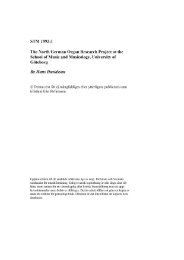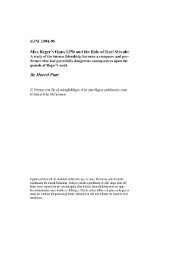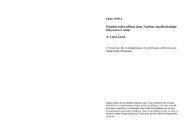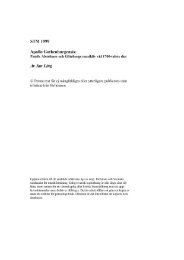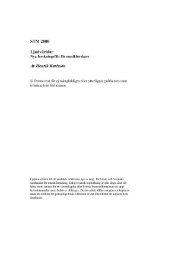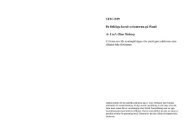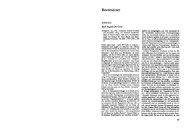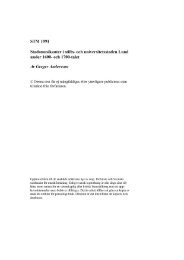Nicolai
Nicolai
Nicolai
Create successful ePaper yourself
Turn your PDF publications into a flip-book with our unique Google optimized e-Paper software.
Zeit, er zieht an unserem Ohr vorüber, er hat seine Dauer; in jedem Augenblick<br />
ist dem Hörenden nur ein Bruchstück präsent. Und dennoch wird er dem Hörer<br />
nicht auseinandergerissen, sondern wird als Zusammenhang, als Ganzes erfasst.”<br />
(P. 117.) In musical listening the movement as a whole is heard as a ”Beisammensein”,<br />
not simultaneously, of course, but as a ”Zusammengehöriges”, an<br />
“Einheit”. The unity of a musical work has the character of a synthesis; the Latin<br />
word ”compositio” is, after all, a translation of ”synthesisss. It is a synthesis that the<br />
listener himself must achieve, and in doing so he is creatively active.<br />
The listener must be continually bearing in mind what has been heard and<br />
anticipating what is to come. Often the outcome or resolution of the musical<br />
suspense is other than what has been anticipated. This phenomenon can also be<br />
observed in the novel and drama.<br />
In some unsuccessful musical works the unity is lacking: ”Es gibt einen Typus<br />
von Kompositionen, in dem die Einzelheiten sich dem Hörer nicht recht zusammenschliessen<br />
wollen, sondern auseinanderfallen. Die Einzelheiten können auch<br />
da noch in ihrer Wirkung gefällig sein, können fesseln, anregen, zur Antizipation<br />
reizen; sie können sogar auf ein Ganzes verweisen. Aber wenn dieses Ganze dann<br />
schliesslich doch ausbleibt, wenn kein Aufbau erscheinend sich herausentwickelt,<br />
empfinden wir das Stück doch als uneinheitlich, flach, nichtssagend. Es ist dann<br />
keine innere Verbundenheit spürbar, es fehlt die Einheit der inneren Gestalt.” (Pp.<br />
120-121.) Such works are failures in genuine composition. And this has nothing<br />
to do with the opposition between serious and ”lighter” music: ”Auch die oberflächliche<br />
Musik, wenn sie wohlgelungen ist-und das will sagen, wenn sie schön<br />
ist-entbehrt der Einheit nicht, und darum auch nicht des erscheinenden Hintergrundes.”<br />
(P. 121.)<br />
Like the drama, music needs a second art (Kunst zweiter Ordnung), which<br />
makes it possible for the composed and written music to be heard. In fact, this<br />
second art is required even more for music than for the drama. Anyone can<br />
”read” a play and with a little imagination can ”see” it. To read a piece of music<br />
is an entirely different matter, requiring special skill and a good deal of practice.<br />
The musical layman is more apt to be able to play a piece than to ”read” it.<br />
The realization of a piece of music is thus dependent upon the musician: ”Dieser<br />
hat freie Hand in der Ausgestaltung zahlloser Einzelheiten der unwägbarsten<br />
Art, die sich im Notenblatt nicht schreiben lassen, an denen aber doch wesentlich<br />
die Gestaltung des Ganzen hängt. Er rückt zum Mitkomponisten auf und ist<br />
insofern nicht bloss ’reproduzierender Künstler’, sondern durchaus produktiv schaffender-nicht<br />
weniger als der Schauspieler im Schauspiel.” (P. 123.)<br />
The composer needs a performing artist who can understand and interpret his<br />
composition. The musician receives from the composer the notation of a musical<br />
work only generally sketched which he completes. But this means that a piece<br />
of music is different for each rendition. Every artist has his personal conception<br />
and thus the identity of a musical work is split up into the qualitative differences<br />
of interpretation. The musician gives full concreteness to a musical composition,<br />
but only for a fleeting moment: ”Die Kunst des ausführenden Musikers bleibt dem<br />
Wesen nach Augenblickskunst.” (P. 12 3.)<br />
Of special importance in the analysis of the aesthetic object are what Hartmann<br />
calls ”Schichten” or strata. A phenomenological analysis reveals strata in the<br />
different art-forms and Chapter 14 is devoted to ”Schichten des Musikwerkes”.<br />
There are “outer” and ”inner” background-strata (Hintergrundsschichten) in the<br />
musical work The outer background-strata are degrees (Stufen) of musical unity:<br />
”Da ist z. B. das bekannte Viertaktgesetz, das für solche Einheiten sorgt. An<br />
seine Stelle kann natürlich auch ein anderes treten: immer aber wird es sich um<br />
kleinere geschlossene Ganzheiten handeln, die als solche musikalisch aufgenom-<br />
men und wie Bausteine verwandt werden.” (P. 198.) These basic phrases or<br />
periods are near being within retention and have the effect of sensually heard<br />
unity, although they are, strictly speaking, beyond retention. ”Die zeitlich aus-<br />
einandergezogene Ganzheit beginnt in ihnen sich zusammenzuschliessen.” (P.<br />
198.) Then there is the recurrence of the motive together with its development.<br />
This is the principle of the variation. From this principle comes the form ”theme<br />
with variations” which can also be incorporated in the sonata form. The outer<br />
background-strata include: 1) basic phrases or periods, 2) theme and variations<br />
(in the wide sense), 3) musical movements (Satze), and 4) the unity of the<br />
movements in a large work.<br />
The transition to the inner strata of the musical work is without doubt a leap<br />
(Sprung). In the outer strata we are still dealing with musical form and the ”Spiel<br />
der Töne und Harmonien”, and are not yet in the realm of emotions and moods<br />
(Stimmungen). But with the inner strata there is a transition to another kind:<br />
”Dieses ist ein höchst Subjektives, ganz dem Seelenleben Zugehörendes, jenes<br />
{the outer strata} ist das Objektivste, das man sich denken kann, ist rein konstruk-<br />
tiver Aufbau, analysierbar, gegenständlich. Das mit den Innenschichten Auftre-<br />
tende, das Seelische, wird niemals ganz gegenständlich, verharrt in seiner Sub-<br />
jectivität, ist schwer greifbar, meist kaum benennbar, wenigstens nicht adäquat,<br />
ist überhaupt nur im hingegebenen Hören da und ausserhalb seiner selbst schwer<br />
vorstellbar.” (Pp. 199-200.) ”Das Seelische” is only there in the musical ex-<br />
perience. Thus musical listening can be characterized as ”Erleben”. ”Ist dieses<br />
Erleben vorbei, die Musik verklungen, so bemüht man sich vergebens, das Er-<br />
lebte wieder in die Gegenwärtigkeit hineinzuzwingen.” (P. 200.)<br />
No wonder, says Hartmann, that the strict music theory rejected all considera-<br />
tion of emotional content as sentimentality (a famous proponent of this type of<br />
theory was Hanslick). According to this type of musical theory, music is a strict<br />
architectonic structure and has its own laws (Eigengezetze), which are purely<br />
structural. Thus music ”kommt also gam ohne Gefühle aus”. And the structural,<br />
including timbre, transitions, modulations, etc., is enough in itself to let a whole<br />
world arise, purely in tone. Those who defend this theory point to an architectu-<br />
rally strict form of composition, namely the fugue, to show that the autonomy of<br />
counterpoint is proof of the superfluity of all ”interpreted in” emotions. However,<br />
according to Hartmann, the master of counterpoint, J. S. Bach, is proof of precisely<br />
the opposite. Take, for example, the first four pieces from the Art of the fugue,<br />
the ricercar from A musical offering, or any fugue from The well-tempered clavier:<br />
’’man wird, sobald man die Technik des angemessenen Hörens einmal erfasst hat,



